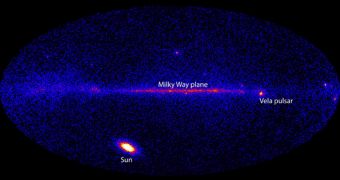According to officials at NASA, the Fermi Gamma-ray Space Telescope has recently been able to observe the most energetic light ever produced by a solar flare. The event, which took place on March 7, demonstrates that the observatory can indeed be used to study the Sun, as some proposed.
This spring's blast was very powerful, so much so that it was able to produce an extremely intense burst of photons that nearly overwhelmed the telescope's detectors. In addition to being very mysterious, solar outbursts also have the potential to reveal more insights into how the Sun functions.
Each flare releases vast amounts of light (at multiple wavelengths) and charged particles. In some instances, the ejecta plume may be headed on a collision course with Earth. The March 7 event was cataloged as a X5.4-class, one of the strongest possible on a star the size of the Sun.
According to astronomers, the flare released massive amounts of gamma rays, a type of light that is more energetic than X-rays. In fact, the Sun produced so much of these radiations that it briefly became the most luminous object in the sky at gamma-ray wavelengths.
This was, without a doubt, the most intense explosion ever detected by the satellite's Large Area Telescope (LAT). Fermi launched to space on June 11, 2008, and this was the most intense flare it observed since then.
“For most of Fermi's four years in orbit, its LAT saw the sun as a faint, steady gamma-ray source thanks to the impacts of high-speed particles called cosmic rays,” researcher Nicola Omodei explains.
“Now we're beginning to see what the Sun itself can do,” adds the investigator, who holds an appointment as an astrophysicist at the Stanford University, in California.
She presented the findings to colleagues gathered at the 220th meeting of the American Astronomical Society, which was held on June 11, in Anchorage, Alaska. LAT, Omodei adds, was able to detect gamma rays with two billion times the energy of visible light.
This energy level, of around four billion electron volts (GeV), is around 1,000 times greater than what the Sun usually produces. In addition, the emissions lasted for about 20 hours, which is significantly longer than any similar event on record.
“Merged with available theoretical models, Fermi observations will give us the ability to reconstruct the energies and types of particles that interact with the sun during flares, an understanding that will open up whole new avenues in solar research,” University of Maryland in College Park astrophysicist Gerald Share concludes.

 14 DAY TRIAL //
14 DAY TRIAL //